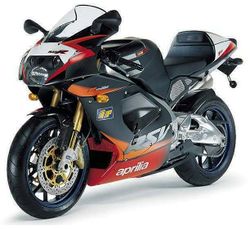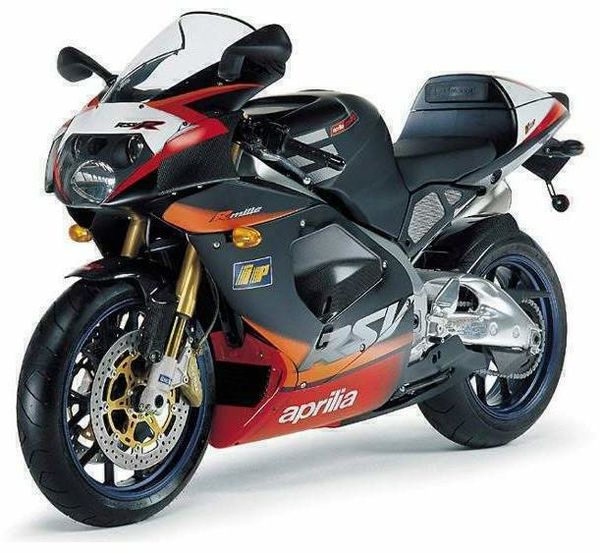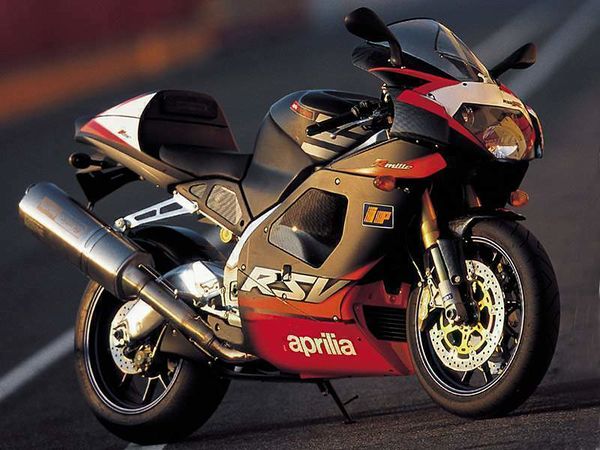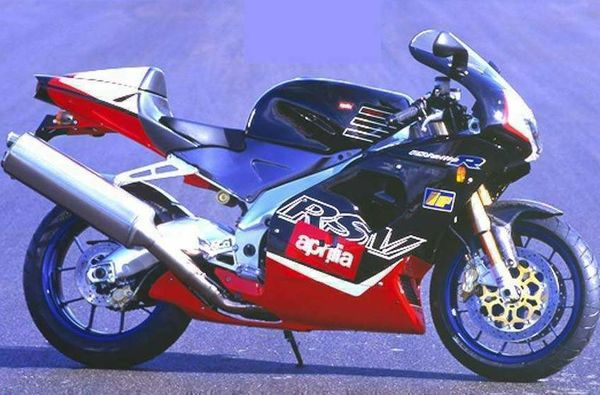Aprilia RSV1000 Mille R
 |
|
| Aprilia RSV1000 Mille R | |
| Manufacturer | |
|---|---|
| Production | 150 units |
| Engine | Four stroke, longitudinal 60°V twin, DOHC, 4 valves per cylinder |
| Compression ratio | 11.4:1 |
| Top Speed | 274 km/h / 170 mph |
| Air Filter | K&N AL-1004 `04[1] |
| Ignition | Digital electronic with one spark plugs per cylinder |
| Transmission | 6 Speed |
| Suspension | Front: Upside-down Öhlins fork, Ø43 mm titanium nitride treated sleeves. Rear: Swing arm in Aluminum alloy, progressive linkage with APS system. Öhlins Racing hydraulic shock absorber |
| Brakes | Front: 2 x Ø320 mm discs, 4 piston calipers, Brembo Gold series Rear: Single Ø220 mm disc, 2 piston caliper, Brembo Gold series |
| Front Tire | 120/70 ZR17 |
| Rear Tire | 190/50 ZR17 |
| Wheelbase | 1418 mm / 55.8 in |
| Seat Height | 825 mm / 32.5 in |
| Weight | 183 kg / 403.4 lbs (dry), |
| Fuel Capacity | 20 L / 5.2 US gal |
| Manuals | Service Manual |
It could reach a top speed of 274 km/h / 170 mph.
Engine[edit | edit source]
The engine was a Liquid cooled cooled Four stroke, longitudinal 60°V twin, DOHC, 4 valves per cylinder. The engine featured a 11.4:1 compression ratio.
Drive[edit | edit source]
Power was moderated via the Multiple disk in oil bath with patented PPC Claimed Horsepower: -assisted hydraulic control..
Chassis[edit | edit source]
It came with a 120/70 ZR17 front tire and a 190/50 ZR17 rear tire. Stopping was achieved via 2 x Ø320 mm discs, 4 piston calipers, Brembo Gold series in the front and a Single Ø220 mm disc, 2 piston caliper, Brembo Gold series in the rear. The front suspension was a Upside-down Öhlins fork, Ø43 mm titanium nitride treated sleeves. while the rear was equipped with a Swing arm in Aluminum alloy, progressive linkage with APS system. Öhlins Racing hydraulic shock absorber. The RSV1000 Mille R was fitted with a 20 L / 5.2 US gal fuel tank. The bike weighed just 183 kg / 403.4 lbs. The wheelbase was 1418 mm / 55.8 in long.
Photos[edit | edit source]
Overview[edit | edit source]
Aprilia RSV 1000 Mille R
The basic RSV Mille is a very competent bike, both for
track and road use. But in 1999, Aprilia released the RSV Mille type 'R',
featuring a host of modifications aimed at making it more effective on
track. Outwardly, the differences are hard to spot. The 'R' has only a
single seat (although a twin seat is an option). The front forks are fully
adjustable Öhlins items and the rear shock is a race-spec Öhlins unit, also
fully adjustable. The 'R' also wears lighter, forged aluminum Oz wheels.
The engine is unchanged, but the 'R' model's chassis modifications make it
much more accomplished on the race track. The 'R' is 4kg (8.81b) lighter,
and this, together with the more refined suspension, allows higher cornering
speeds and quicker steering.
Several weeks ago I came home from another day at
the grind. There was a message from the editor of American Roadracing/2wf.com;
he wanted to know if I could go to Spain for the Aprilia RSV Mille R launch. I
asked myself, "Should I go to Spain and ride the new bad ass Aprilia
?" Without
hesitation, I returned his call; too bad for him he is too busy to go.
A week before my trip, a friend took out one of the standard Mille RSVs from Scuderia West - our local San Francisco Aprilia dealer - and after flogging it around the city, he told me that it was a bitch'n bike. The next thing you know, I'm on a plane for Spain laughing the whole way in anticipation.
The RSV Mille R is meant to bridge the gap between the ultra trick, very expensive ($32,000.00), hard to get (150 units only, this year) RSV Mille SP and the standard RSV. The Italians have produced some very beautiful bikes over the years and this is no exception. I hoped it worked as good as it looked.
The first morning in Spain it was raining a little at the track. Never fear, we grabbed our stuff and piled into a van and headed to it. The Valencia circuit is a great track that's only a few years old. The track surface is smooth and the layout is real cool; not too fast with plenty of turns and hard braking spots. There are a few tricky spots, too, like the big sweeper leading up to the last hairpin. You just don't know how fast to go, then you can't quite tell where to start braking so you tend to brake too early or to overshoot. The grandstands circle three quarters of the circuit so the spectators can see the whole track layout pretty much from anywhere they sit, and the garages are state of the art. It must be like a crazy bullfight there when the races are going on, people yelling from every corner of the track and you'd see and hear them all.
Inside the Mille R
The Mille R features an Ohlins upside-down 43 mm fork with titanium nitride coating on the tubes and gold anodized sliders. External rebound and compression adjustments are easy to use, and the brake hanger is a one-piece forged aluminum bracket that is more rigid than conventional caliper mounting plates. The rear shock is also an Ohlins unit with the usual compression and rebound adjustments. There is plenty of room between the swingarm and subframe, so spring preload can easily be adjusted.
One of the big things about the R model is its revolutionary wheels. The OZ wheel company, a front runner in F1 car technology, produced the lightweight wheels with just the right amount of rigidity. The wheels are made from Anticorodal 5051 forged aluminum in an 8000 ton forging press. This technology enabled the production of a wheel free from porosity. A finite element analysis proved that the six spokes dividing towards the edge of the channel was the best choice and that this structure in fact permits optimum lateral and torsional rigidity. The weight saved on these wheels is exceptional, about 25% less per wheel compared to the lightest OEM cast aluminum rim. The wheel weight reduction reduced the wheel's inertia by 25%, which should make the bike more "flickable." The manufacturing process allowed the wheels to be as light as magnesium wheels but without the corrosion problem.
Brembo Gold Series brakes are featured front and rear. The front brakes are 320 mm double floating stainless steel rotor and the calipers feature varied piston diameters of 30 mm to 34 mm and are complemented by new sintered brake pads for outstanding stopping power.
The Aprilia RSV Mille R engine incorporates a number of the new features and technical solutions for all year 2000 model RSVs. The standard sixty-degree V-twin motor has been significantly modified to improve efficiency and range of use. The injection mapping has been modified for better start-up and output at low revs, and to reduce jerkiness during deceleration. Aprilia claims that these modifications also reduce noise levels. The clutch assembly has been improved with a braided line, and clutch plates are made from a different friction material. Spring pressure has also been reduced for less lever resistance.
What I really liked was the patented Pneumatic Power Clutch (PPC), which is a vacuum-actuated slipper clutch. What this means is that, when you get off the gas for a corner, the clutch slips, and when you get back on it, it grabs again. This process is activated by carburetion vacuum and cuts down on rear wheel hopping, which we all hate so much on big twins. The transmission has also been reworked. I have never ridden a bike with smoother shifting.
When it comes to the chassis, the R model uses the same
polished aluminum frame and swingarm as the standard Mille except the steering
tube has been beefed up to the SP specs for more rigidity. The subframe is also
aluminum for weight reduction. An Ohlins adjustable steering damper is standard
on the R, but the bike worked so well with it in the light position that I never
even used it. Acerbis made the lightweight, scratch-resistant gas tank using
special resins in a rotary nylon configuration. This was less expensive yet
stronger than aluminum and, not to mention, a whole lot tricker. Aprilia knows
that riders are going to total a tank or two, so they wanted to make sure that
the privateer could afford a new one. Carbon fiber front and rear fenders and
dash cover also make the R model special.
The Mille R on Track
For our first session, an intermediate rear was mounted because it was cold and the track was still a little wet in spots. The bike moved around a lot mid-corner and felt soft in the rear. I came in to tighten up the rear spring, but since there was only a little time left in the session, I went back out quickly to get more familiar with the track. For my next session, I asked Dario to add a turn and a half of preload to the rear and two clicks of compression and rebound to the front. The Pirelli and Aprilia guys told me that the intermediate tire on the rear might account for why the bike was moving around and felt soft. Dario changed the rear tire and they told me that I might not want to change the suspension. I thought, "What are they, high?"
I overruled their decision and Dario made the changes I requested. As Dario worked on my bike, I noticed the word lap on the left handlebar blinker switch so I asked him, "What does that do?" He said that it is a switch you can press on every lap to see your times and that it will count laps, record your times, and play them back. On the dash, there are four letters, A B C D, and if you push them in the right sequence, it will bring up the times. This is standard. Wow! That's great, unless you're slow as shit and don't want anyone to know.
Back on it the second time, the bike felt great right away. The track was dry for this session and, once I scrubbed in the new rear, I started to really get into it and the bike responded accordingly. The power delivery is smooth and precise, and changing direction was no problem. The R doesn't get out of shape no matter how hard you brake or gas it, and in mid-corner it holds its line very well. Only later in the day did the bike tend to stand up a bit on the exit.
The transmission shifts down easily and with the slipper clutch working there is no rear tire hopping. Just throw it in and plant your knee. With the front Pirelli 120/65/17, the turn-in action is achieved with relative ease just as they designed it to be.
On the exit of the turns, hard on the gas, the front would get light but it still held its composure. The Valencia kink puts the rider on the wrong side of the track for turn four but, never fear, the R will go where you want it to. The lighter wheels and smaller front forks are key to this maneuverability.
The R might get out of shape on track but still has a very confident feel about it. This kind of control is uncommon on a production motorcycle. It created confidence while riding the tricky sections of the track, such as where I would short-shift up two gears while leaned over, keeping the gas on, anticipating exactly where the mystery brake marker (I called it that because there is no reference point) was hiding. Here's where I thought the bike could use a bigger front tire because the rider is leaned over on the brakes hard, coming down the hill and the front seemed to squirm around. It really wasn't a problem, but I feel it could be in the heat of a race battle. Once slowed down enough, I could negotiate the last corner properly, and I often changed my lines so that I could get a better drive out and make a pass. The R would easily go wherever I wanted it to, no problem.
The harder I rode it, the easier it was; just like with a finely tuned race bike. Every time I went out on it, I would look down at the steering damper and think I should adjust it but I never did, and it made no difference. Before I went out on my last bomb session, I thought about lowering the front five mm to see if it would hold the line a little tighter exiting the corners. I had the thing leaned over so far that I was starting to scrape the pegs. I wondered if maybe I shouldn't raise the rear, too. Who knows? It was working so well, why bother?
Even after riding all day, I still felt as though I could go 50 more laps. The R didn't take much energy to ride and was very comfortable. All an all, it is a very exceptional bike, which can be exploited to its full potential straight out of the box. I have never before ridden a bike that works so well and is so easy to ride.
There are to be only 150 of the R models built this year but I think that the success of this bike will bring a demand for many more. In Europe, they have a Superstock class that is 750cc and up and allows only slight mods. This Aprilia works so well in standard form I think it will kick ass. Unlike the R1s and CBR900s and the others, the Aprilia won't need heavy fork mods or a rear shock replacement to be competitive. It's ready to go right now.
At the end of the day, I said my good-byes and went into town to reflect on the day's events. Later that night, I hooked up with the English journalists and we pounded beers, covering the pros and cons of the RSV Mille R, and it seemed to be all good and no bad. It wasn't the booze talking, either. My conclusion is that the RSV Mille R is a great bike.
Source
| Make Model | Aprilia RSV 1000 Mille R |
|---|---|
| Year | 1999 |
| Production | 150 units |
| Engine Type | Four stroke, longitudinal 60°V twin, DOHC, 4 valves per cylinder |
| Displacement | 997.6 cc / 60.9 cu-in |
| Bore X Stroke | 97 x 67.5 mm |
| Cooling System | Liquid cooled |
| Compression | 11.4:1 |
| Induction | Fuel injection |
| Ignition | Digital electronic with one spark plugs per cylinder |
| Starting | Electric |
| Max Power | 97.2 kW / 133.2 hp @ 9500 rpm |
| Max Torque | 106 Nm / 10.8 kgf-m / 78.2 ft.lbs @ 7500 rpm |
| Clutch | Multiple disk in oil bath with patented PPC Claimed Horsepower: -assisted hydraulic control. |
| Transmission | 6 Speed |
| Final Drive | Chain |
| Rake | 25° |
| Trail | 102 mm / 4.0 in |
| Front Suspension | Upside-down Öhlins fork, Ø43 mm titanium nitride treated sleeves. |
| Front Wheel Travel | 120 mm / 4.7 in |
| Rear Suspension | Swing arm in Aluminum alloy, progressive linkage with APS system. Öhlins Racing hydraulic shock absorber |
| Rear Wheel Travel | 135 mm / 5.3 in |
| Front Brakes | 2 x Ø320 mm discs, 4 piston calipers, Brembo Gold series |
| Rear Brakes | Single Ø220 mm disc, 2 piston caliper, Brembo Gold series |
| Front Tire | 120/70 ZR17 |
| Rear Tire | 190/50 ZR17 |
| Dimensions | Length: 2035 mm / 80.1 in Width: 730 mm / 28.7 in Height: 1145 mm / 45.1 in |
| Wheelbase | 1418 mm / 55.8 in |
| Seat Height | 825 mm / 32.5 in |
| Dry Weight | 183 kg / 403.4 lbs |
| Fuel Capacity | 20 L / 5.2 US gal |
| Reserve | 4 L / 1.1 US gal |
| Standing ¼ Mile | 10.6 sec |
| Top Speed | 274 km/h / 170 mph |
External Links[edit | edit source]
Videos[edit | edit source]
References[edit | edit source]
- ↑ 2019 K&L Supply Co Catalog. K&L Supply Co. 2019.


